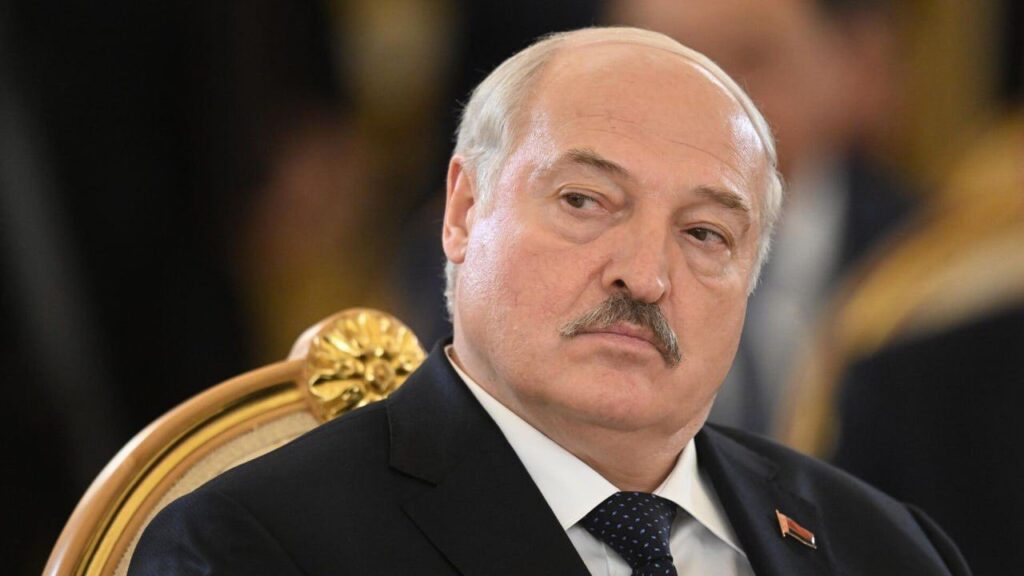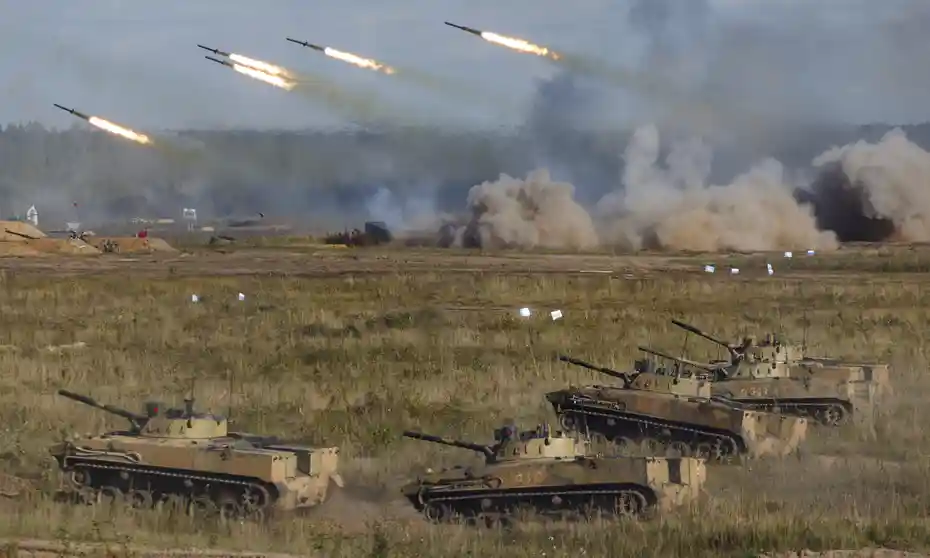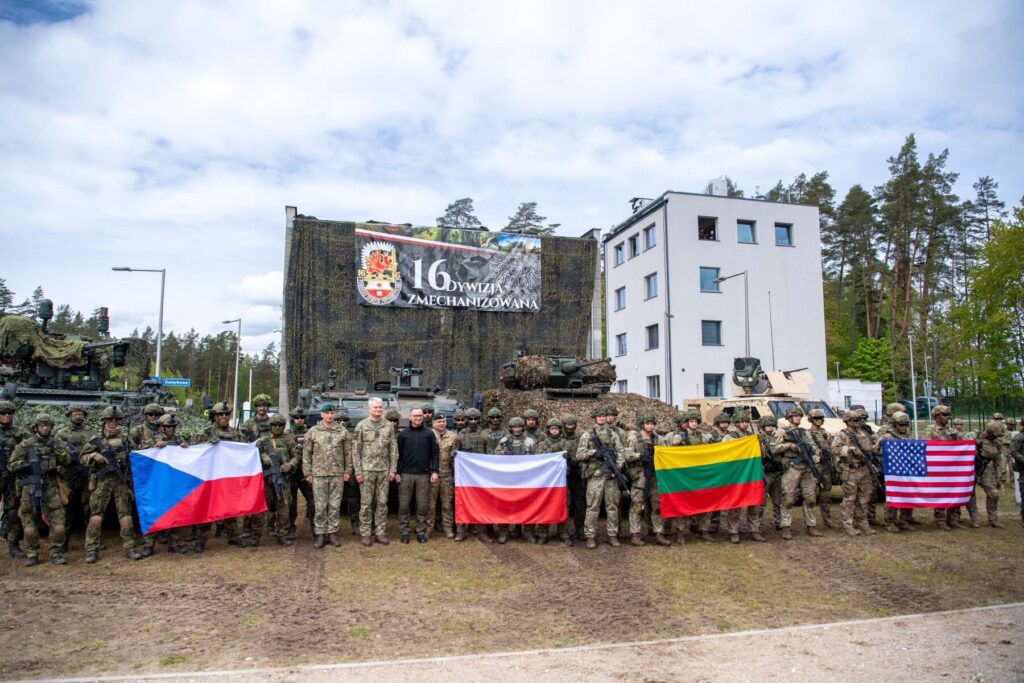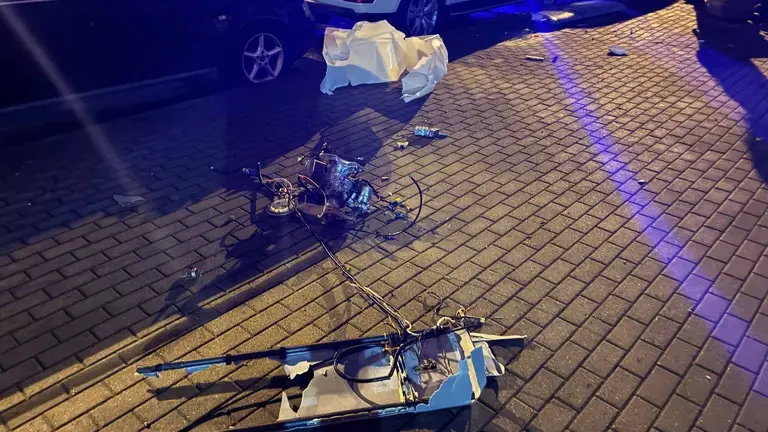On July 29th , an unmanned aerial vehicle (UAV) was downed by Belarusian EW in the Belarusian capital, Minsk. While official sources have remained vague or contradictory, the circumstances surrounding the incident have raised suspicions among analysts and foreign observers. Among the prevailing theories, one stands out as particularly consequential: that the UAV was a Russian-operated drone, intentionally crashed to fabricate a pretext for deeper Belarusian involvement in the war in Ukraine.
As of now, official information about the type of UAV that crashed in Minsk remains vague and highly suspicious, suggesting deliberate obfuscation by the Belarusian and possibly Russian authorities.
What Is Known (and Unknown) About the Drone:
Official Belarusian Claims:
- State media claimed the drone was “Ukrainian” in origin.
- No photos, videos, debris images, or technical analysis were made public.
- Authorities did not present:
- A drone serial number.
- Model type.
- Navigation logs.
- Evidence of Ukrainian manufacture or military markings.
No Independent Confirmation
- No open-source verification or visual confirmation has appeared.
- No international observers were granted access to the wreckage.
- Ukrainian authorities have denied responsibility and called the incident a provocation.
Likely Possibilities Based on Previous Patterns:
If this were a false flag operation by Russia or Belarus, the UAV may fall into one of these categories:
1. Orlan-10 (Russian reconnaissance UAV)
- Russia has previously disguised Orlan-10s in conflicts (e.g., Georgia, Ukraine).
- Small, modular, can be repainted or stripped of Russian identifiers.
- Has crashed before in multiple countries.
2. Commercially Available Drone, Modified
- A Chinese-made Mugin-5 or similar model, modified for military use, is commonly used by both sides.
- Russia has used these in Ukraine and blamed Ukraine for them in prior provocations.
- If used in Minsk, such a drone could be easily planted and made to resemble a Ukrainian craft.
3. Locally Assembled Mock-Up
- In a staged event, no genuine military drone may have been used — just scrap UAV parts arranged to look like wreckage.
Bottom Line:
There is no transparent evidence of the UAV type — and this absence is itself telling. In high-profile drone crashes, states usually release images to support claims. The silence suggests the event may have been fabricated, manipulated, or staged — with a repurposed Russian or commercial UAV likely involved.
II. Context: Belarus’s Ambiguous Role in the War
Since the full-scale Russian invasion of Ukraine in February 2022, Belarus under Alexander Lukashenko has served as a logistical and staging platform for Russian forces, while officially avoiding direct combat participation. Belarus has allowed missile launches and troop deployments from its territory, but domestic opposition to direct involvement remains high. Lukashenko has walked a strategic tightrope, balancing loyalty to the Kremlin with domestic stability and international pressure.
III. The Incident: Known Facts and Anomalies
- The UAV that crashed in Minsk was described by some sources as military-grade, but not publicly linked to any military operation.
- There was no immediate attribution by Belarusian authorities, though state-controlled media hinted at a “foreign drone”.
- Russian Telegram channels quickly blamed Ukraine, without offering evidence.
- However, Ukrainian officials denied any involvement, and international analysts noted that the drone’s flight path and trajectory were inconsistent with typical Ukrainian operations.
IV. Hypothesis: Russian False Flag Operation
Several factors support the hypothesis that Russia staged the UAV crash to provoke Belarus into a more active military role:
- Pretext Creation Strategy
Russia has historically used false flag operations to justify military escalations. Incidents in Donbas (2014), Crimea (2014), and attempted provocations near the Ukrainian-Polish border in 2022 suggest a pattern of engineered incidents to manipulate allies or public opinion. - Strategic Need for Belarusian Troops
As Russia faces manpower shortages and increasing attrition on the Ukrainian front, the Kremlin may be pressuring Lukashenko to open a northern front or at least to divert Ukrainian resources. - Media Synchronization
Russian propaganda channels and commentators reacted unusually fast, providing a narrative before Belarusian authorities had released any evidence. This suggests pre-coordination or knowledge of the incident beforehand. - Internal Messaging in Belarus
Following the incident, Belarusian pro-government outlets increased anti-Ukrainian rhetoric, potentially preparing the population for a shift in policy. This timing aligns suspiciously with the drone crash.
V. Strategic Motives Behind Russian Pressure on Belarus
- Diversion of Ukrainian Forces: A new front from Belarus could stretch Ukrainian defenses and weaken counteroffensives in the south and east.
- NATO Test: Belarusian participation might trigger stronger NATO deterrence measures near Poland and the Baltics, testing Western resolve.
- Internal Control in Belarus: Increased militarization could help Lukashenko crack down on dissent under the guise of national security.
VI. Risks and Limitations for Russia
Despite potential gains, this strategy carries significant risks:
- Public Resistance in Belarus: A majority of Belarusians oppose direct involvement in the war. Provoking a false-flag incident could spark mass protests or destabilize Lukashenko’s regime.
- Credibility Damage: If exposed, such an operation could erode Moscow’s already-fragile credibility among allies and the non-aligned world.
- Operational Blowback: Belarusian military command may resist orders perceived as suicidal or politically toxic.
VII. Alternative Explanations
While the provocation hypothesis is strong, other possibilities exist:
Technical Failure
The UAV might have been a misdirected or malfunctioning Russian or Belarusian drone not intended for public awareness.
- Western Surveillance
Although highly unlikely, Russian propaganda may exploit the incident to frame NATO for reconnaissance or sabotage operations.
VIII. Conclusion
The crash of a UAV in Minsk appears less as a random incident and more as part of a deliberate strategy by the Kremlin. With Moscow growing desperate for strategic leverage in its war against Ukraine, provoking Belarus into military engagement—under the false pretense of defending its sovereignty—fits a historical and tactical pattern. While Belarus has so far resisted full participation, incidents like the Minsk UAV crash signal that pressure from Russia is intensifying, and the next stage of hybrid war may unfold on Belarusian soil.
There have been several cases where Russian drones have crashed or been detected in countries other than Ukraine, often raising alarms about escalation, violations of sovereignty, or intelligence operations. Some notable examples are:
1. Romania
- Date: September 2023 (multiple incidents)
- Location: Romanian territory near the Danube River
- Details: Russian drones targeting Ukrainian ports on the Danube repeatedly crossed into and crashed in Romania, a NATO member.
- Reaction: Initially denied, but later confirmed by Romania’s Ministry of Defense after debris was discovered. NATO condemned the incident but avoided escalation.
- Interpretation: Likely accidental overshoot, but raised serious questions about Russia’s disregard for NATO borders and potential for dangerous miscalculation.
2. Moldova
- Dates: Multiple, including October 2022 – 2024
- Locations: Border areas such as Naslavcea, Briceni, and northern Moldova
- Details: Russian missiles and drones launched at Ukrainian targets near the border occasionally crashed in Moldovan territory.
- Reaction: Moldova lodged formal protests and condemned Russia’s military actions as a threat to regional stability.
- Interpretation: Both overshoots and possible testing of Moldovan response readiness. Contributes to tensions in an already politically divided country with pro-Russian factions.
3. Poland
- Date: December 2022 (and suspected earlier)
- Location: Village of Przewodów (missile incident); later drone sightings in border forests
- Details: A missile killed two Polish civilians — though ultimately attributed to a Ukrainian air defense missile, the initial fear was that Russia had directly attacked a NATO country. Additionally, several unconfirmed drone sightings raised concerns of surveillance or targeting NATO logistics routes.
- Interpretation: Heightened alert for NATO and NATO’s eastern flank security mechanisms. Prompted expanded air defense deployments.
4. Croatia
- Date: March 10, 2022
- Location: Zagreb, Croatia (NATO country)
- Details: A Soviet-era Tu-141 drone crashed in a park in Zagreb after flying over Romania and Hungary.
- Official Statements: Believed to be a Ukrainian drone that went off course, but the incident highlighted weaknesses in NATO’s airspace monitoring.
- Public Reaction: Sparked public outrage and criticism of NATO’s lack of timely interception.
5. Belarus
- Dates: Multiple unconfirmed incidents, including the July 2024 Minsk crash you referenced
- Details: Drones (either recon or provocation tools) reportedly entered Belarusian airspace.
- Interpretation: May include Russian false-flag attempts, Ukrainian intel probes, or disinformation from Belarus to justify internal repression or militarization.
Conclusions:
- Pattern: Most incidents involve drones overshooting targets near border regions (especially near Odesa and southern Ukraine).
- Risks: These incursions carry high escalation potential, particularly when NATO member states are involved.
- Interpretation by Experts: Some of these may be deliberate probing actions by Russia to test reactions and pressure neighboring governments; others are likely collateral outcomes of chaotic war dynamics and poor drone navigation systems.
The most likely version of the UAV crash in Minsk is that it was a deliberate Russian false-flag operation designed to:
► Provoke Belarus into active participation in the war against Ukraine
or at least
► Justify further militarization and integration of Belarus into Russia’s war logistics and command structure
Analytic Breakdown of the Likely Version
1. Context and Timing
- The crash occurred in Minsk, not a border region — making an accidental overshoot highly unlikely.
- It happened amid growing pressure from Russia on Belarus to step up its involvement in the war effort.
- Lukashenko’s regime remains reluctant to send troops into Ukraine, fearing internal unrest and military disloyalty.
2. Nature of the Drone
- No independent identification of the drone model has been confirmed.
- Belarusian officials claim it was “Ukrainian,” but offered no verifiable proof.
- The location and controlled nature of the crash suggest it was not shot down, but landed or brought down intentionally.
3. Russian Strategic Goals Behind a False Flag
- Manufacture a casus belli to push Belarus closer to direct combat involvement.
- Test internal Belarusian response — from military command to public opinion — to a supposed Ukrainian attack.
- Justify security crackdowns and mobilization within Belarus under the pretense of “national defense.”
- Distract from setbacks in Russia’s own war efforts by fabricating Ukrainian aggression on allied soil.
4. Belarusian Caution and Response
- Lukashenko has not used the incident to declare war, suggesting:
- Either he doubts the origin of the UAV himself,
- Or he is resisting Kremlin pressure for deeper involvement.
- Belarusian statements are muted and vague, hinting that the regime is walking a tightrope — maintaining the appearance of alliance with Russia while avoiding full commitment.
Conclusion:
The most plausible explanation is that Russia staged the UAV crash in Minsk — either directly or through its assets in Belarus — to provoke a reaction or gradually shape public and elite opinion in favor of joining the war. This fits within Moscow’s broader strategy of coercive integration and proxy manipulation in its satellite states.
The UAV incident in Minsk — especially under the suspicion that it was a false flag operation by Russia — has significant political implications for Belarus, Russia, and the war in Ukraine. Below is a breakdown of the meanings and consequences:
1. Pressure on Belarus to Join the War
- Primary Goal: If the UAV was Russian and the incident was staged, it likely aimed to provoke Belarus into deeper military involvement in Ukraine.
- Context: Despite being a close ally, Belarus has so far avoided direct troop deployment into Ukraine. Russia is increasingly pressuring Lukashenko to act more aggressively.
- Why Now: With Russian military stretched thin and Ukraine gaining traction in drone warfare, the Kremlin may be trying to open a northern front via Belarus — or at least force Ukraine to divert resources northward.
🛑 2. A Warning Shot to the Belarusian Public and Opposition
- Internal Messaging: This incident allows Lukashenko’s regime to frame Ukraine as an aggressor, justifying more repression or conscription under the guise of “national defense.”
- Narrative Control: The drone crash might be used to create a pretext for militarization, internal crackdowns, or tighter border controls — especially ahead of potential unrest or elections.
3. Russian Strategy: Proxy Escalation and Manipulation
- Hybrid Provocation: Russia benefits by outsourcing aggression to Belarus while denying direct involvement, consistent with its hybrid warfare doctrine.
- Distraction: If real, the incident could be used to distract from Russian losses elsewhere or justify broader retaliation.
- Testing NATO/EU Reactions: A drone crash in Minsk allows Moscow to test how far provocations can gowithout triggering direct Western responses.

More on this story: Signs of Russian provocation being prepared in Belarus to drag Minsk into war


4. Implications for the Region and NATO
- Heightened Regional Tensions: This increases instability on NATO’s eastern flank (Poland, Lithuania, Latvia).
- Pretext for Stationing More Russian Troops: Belarus could invite more Russian troops “for protection,” deepening its de facto occupation and creating a platform for future escalation.
Strategic Interpretation:
The most plausible interpretation is that Russia engineered this drone incident to:
- Push Belarus into war or escalate regional tension,
- Justify internal repression within Belarus,
- Distract Western attention, and
- Test the limits of hybrid provocations without overt aggression




